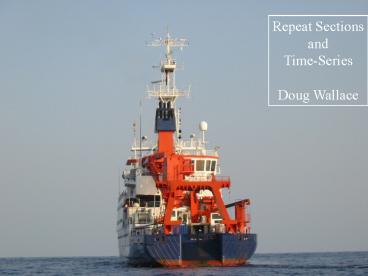Repeat Sections - PowerPoint PPT Presentation
1 / 22
Title:
Repeat Sections
Description:
Repeat Sections – PowerPoint PPT presentation
Number of Views:38
Avg rating:3.0/5.0
Title: Repeat Sections
1
Repeat Sections and Time-Series Doug Wallace
2
What are we trying to do?
- Assess multi-year DIC increase.
- (also O2, 13C)
- validate carbon cycle models
- Understand factors controlling Cant uptake
- Watch for evidence of feedbacks
- (e.g. ?Alk)
3
Assessments Oceanic CO2 Uptakee.g. Bates et
al., 2002
- Fixed-point time-series since 1988
- Mode Water DIC increase much greater than
expected - Increased sea-to-air transfer in formation
region reduced ventilation by convective mixing
in ocean interior - Short-term storage (sub-decadal)
- Extra 0.03-0.24 PgC yr-1
- (2 billion yr-1)
4
Zwischenjährliche Variabilität des
Konvektionsprozesses
Salzgehalt LSW Bildungsrate
aus A6/A4
(von Lazier)
Temperatur
aus A2
5
Cant concentrations and inventories can be
estimated from observations
From Wallace (2001)
6
Cant can be estimated from observations (cont.)
From Wallace (2001)
7
Increase patterns of different anthropogenic
tracers along WOCE A2 (48N) from Friis, Wallace
and Körtzinger (in revision for GBC)
CMP
eMLR
8
Transport-Based Budget from Holfort et al.
(1998)Importance of Meridional Transport
- Emphasised role of meridional transport
- Budget consistent with air-sea flux estimates
- Transport of Cant
- Regional budgets for Cant
- ?? (observation-based) Cant
air-sea flux - Dominant role for transport in North/Equatorial
Atlantic Cant budget
9
Re-assessment of Cant Transport
- NOAA 24.5N section in 1998
- compared with 1992 section
- from MacDonald, Baringer, Lee, Wallace and
Wanninkhof (In Press)
1992 Cant Transport 0.17 ?0.06 PgC yr-1 1998
Cant Transport 0.20 ?0.08 PgC yr-1
10
24.5?N Transport of Heat and Cant
Means from Hydrographic Sections
SFB Modelling (at 1/3 resolution) shows that
heat and Cant Transports are tightly correlated
at 24.5N(Hydrographic section transports from
MacDonald et al., In Press)
Global carbon cycle models have tended to
meridional underestimate heat transport
11
Ocean warming and stratification changes
complicate/alter assessments of Cant budgets
using atmos. oxygen time-series. ? Economic
Implications!!
Plattner et al.,
Bopp et al, 2001
12
DI13C changes An Alternative for Cant Storage
Estimation
The atmospheric trends of increasing pCO2 and
decreasing 13C are recorded within the
sub-surface ocean.
- From Körtzinger, Quay and Sonnerup (In Press)
13
What measurements do we need?
- CT, AT, 13C, O2, nutrients, DOC
- CFCs, CCl4 (!!!), 3H/3He
- New tracers
- New approaches to measuring and assessing
inventories
14
What Observational Strategy?
- Depends on issue being addressed
- STORAGE ?CT signal should be big
- TRANSPORT mass transport should be estimable
(CLIVAR cooperation) - UPTAKE vertical upward motions should be large
15
CAVASSOO (Carbon Variability Studies by Ships of
Opportunity) ANIMATE (Atlantic Network of
Interdisciplinary Moorings and Timeseries for
Europe) SFB 460 (Dynamik thermohaliner
Zirkulationsschwankungen)
16
Examine Decadal Basin-Scale Cant Increases (and
?O2) (Build on Prior Hydrographic Surveys)
- TTO provided an early 1980s baseline of
high-quality CO2 and carbon isotope data - Cruises planned for the German SFB460
(2003-2004) combine with international plans to
provide an outstanding basis for evaluating the
CO2 increase over 2 decades - This fieldwork can also address
- The Cant export from the sub-polar to the
sub-tropical gyre with the THC - The Cant uptake from the atmosphere via a
regional mass balance for Cant north of 24.5N - O2 and nutrient changes since TTO
17
Projections of Future Cant, CO2 and O2 Uptake
Requires Credible Models
1/3? resolution shows significant structure in
air-sea flux of Cant
18
Projections
- Projection requires credible models. Oxygen and
CO2 distributions are controlled to 1st order by
temperature, heat fluxes, and difficult-to-model
vertical processes. Biogeochemical models must
therefore be at least as good as state-of-the-art
climate models. - QUESTIONS
- Is it sensible to have separate biogeochemical
and climate modelling communities and programs? - Should we abandon global biogeochemical models
and shift to higher resolution basin-scale
models? - How can we quality-assure biogeochemical models?
19
What do we need to develop?
- Shipboard measurements much more efficient
measurement systems and approaches are needed for
all hydrographic measurements (incl. CTD) - ARGO and gliders lets do O2
- Moorings we need commercial products (and
funding similar to that of PO) - Reference materials incl. for nutrients and QC
procedures for O2
20
Shipboard measurement equipment is not yet fully
developed
21
Utilize emerging technologies and platforms(e.g.
ARGO)
An ocean full of profiling floats ideal for
measuring O2 inventories
22
Opportunities and Needs
- Long overdue a critical assessment of ocean
carbon modelling capability. - Model-based testing of Cant identification
techniques - Basin-scale planning and working groups.
- Real interest, committment and cooperation from
the PO community. - Time-series sites in key regions.
- Multinational time-series sites.
- Scientific collaborations to make the cruises and
time-series more interesting...































